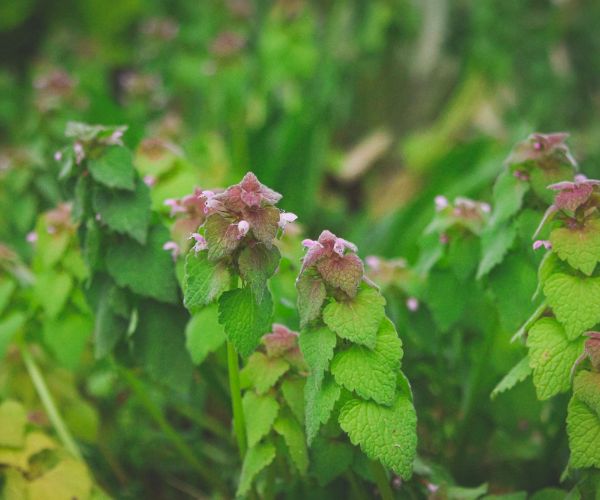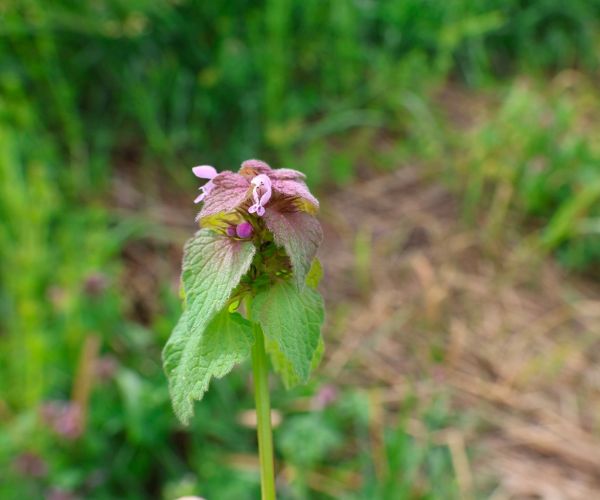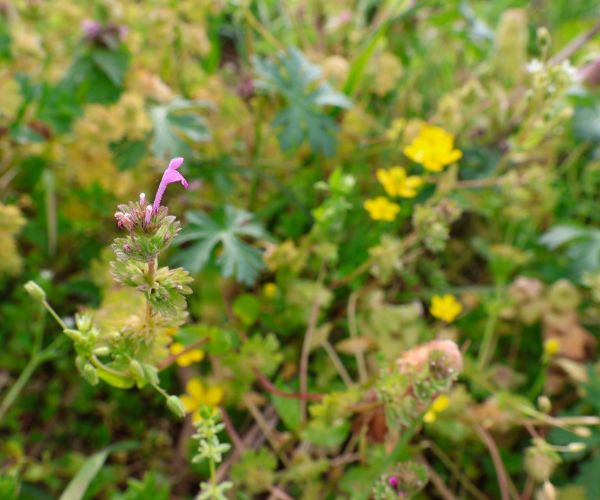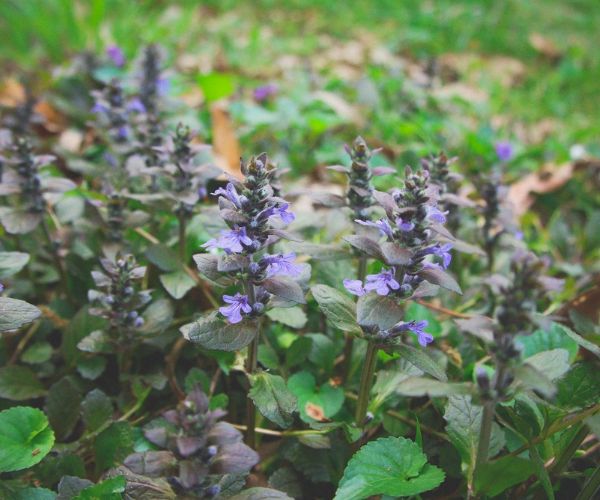Want to forage purple dead nettle like a pro?
This pretty little perennial probably grows somewhere near you. But you might not know exactly where to search or how to tell it apart from the look-alikes.
It pays to learn the basics. I’m here to help with a complete guide to purple dead nettle so you can identify, forage, and harvest these beneficial plants in no time.
How to Identify Purple Dead Nettle

Every forager’s first step is proper identification. Let’s get to know this plant so you can instantly pick it out of a weed lineup.
Known scientifically as Lamium purpureum, purple dead nettle is a member of the mint family. It’s named for its resemblance to stinging nettle, but the two aren’t related, and you won’t find any barbs on purple dead nettle. Instead, it’s soft and fuzzy to the touch.
While it might not be the traditional nettle you’re used to, it is definitely purple. You can often spot a patch from far away because the entire ground area will have a purplish tint to it. Once you get up close and personal, you’ll need to examine the stalk, leaves, and flowers to confirm your identification.
- Leaves: This plant has triangular, serrated leaves that grow symmetrically off the stalk. The leaves are very fuzzy and tend to droop as the plant grows, enough so that they often fold over the leaf below them. They may be dark purple or violet on the upper plant and green on the lower portion of the stalk.
- Flowers: Purple dead nettle has small, bright pink flowers. The blooms are lipped, with an upper petal and two lower petals. They point downward and provide an important food source for bees in early spring. You may see only one flower on the plant, but some sprout quite a few.
- Stalk: Purple dead nettle is a low-lying ground-cover weed with a short, hollow stalk. The stalk is square and may grow up to ten inches high, though most plants only reach four or five inches. If the stalk is very tall, the leaves and flowers may only populate the upper portion.
Remember that all plants and flowers have some natural growth variations. Purple dead nettle may look slightly different from region to region because of temperature and soil differences. However, the unique downsloping shape and purple tinge on the leaves are a dead giveaway.

Purple Dead Nettle Look-Alikes
Fortunately, purple dead nettle has no poisonous look-alikes to worry about. However, it does have two distant cousins that might trip you up as you forage.
Henbit

New foragers commonly confuse henbit for purple dead nettle. Both plants belong to the mint family and crop up during springtime.
You’ll often see henbit and purple dead nettle growing beside each other, which can be confusing. But upon closer examination, henbit is easy to distinguish.
Instead of growing opposite each other and drooping downward, henbit leaves appear to grow in shelves and stick straight out.
They wrap around the stalk in a fan-like shape, with lots of space between vertical leaf sets. These leaves are shorter, wider, and less fuzzy than purple dead nettle. Henbit flowers have a similar shape and color to purple dead nettle but appear tubular and long rather than short.
If you find it: Snatch it up! Henbit is edible. I find it tastes much sweeter than purple dead nettle, and you can use it the same way.
Creeping Charlie

Creeping Charlie is another mint family member resembling purple dead nettle. But when you look closely, you’ll most likely see the creeping Charlie leaves growing in alternating patterns instead of symmetrical ones.
The leaves aren’t as fuzzy and may be triangular or rounder with scalloped edges. Depending on your region, they can be bright green or a much darker, deeper shade of green. The flowers are a dusky violet-purple with five leaves, though they form an upper and lower lip similar to purple dead nettle.
If you find it: Snatch it up! Creeping Charlie is a delicious alternative to purple dead nettle. I find it much more aromatic and use it primarily for tea.
How to Forage Purple Dead Nettle
Purple dead nettle isn’t very particular. It’s an invasive species native to Europe and Asia and is incredibly hardy and flexible. Cooler temperatures pose no problem for this plant, so it has little competition in early spring.
Purple dead nettle comes up practically overnight and can self-pollinate if necessary. In fact, it spreads so quickly and easily that it’s actually considered a weed by many farmers and homesteaders. While the rapid reproduction rate may irk some people, their loss is your gain.
It means you won’t have any trouble finding purple dead nettle if you know where to look.
When to Search
Here in the Ozarks, purple dead nettle is one of the earliest springtime edibles. It comes up in March and persists until May when hot summer temperatures scorch it to death. Surprise late-spring cold snaps don’t seem to bother it at all, and I’ve seen it clutching onto life even in the dog days of June.
Purple dead nettle thrives in USDA hardiness zones four through eight. Varying degrees of humidity, warmth, and sunlight in these zones will affect the exact dates it appears.
Generally speaking, you should start looking in late winter and early spring. Depending on where you live, you may be able to forage purple dead nettle for three, four, or even five months during the spring-to-summer transition. Some lucky people will find it all year long.
Where to Search
Purple dead nettle grows somewhere in every single state. It prefers full sun and moist soil, though you can also find it in partial shade. You’ll most likely see it in yards, meadows, and along forest edges. Keep an eye out for cousins Henbit and Creeping Charlie because all three tend to grow together.
Purple dead nettle often spreads across tilled fields that haven’t yet been sown and in areas where the soil has been recently disturbed. It may creep along waste areas like abandoned parking lots, and you’ll often find it growing in the same places year after year.
Because it’s so resilient, you never know where it might crop up—but with that being said, you don’t want to harvest from just any old place.
Where Not to Gather
I often see purple dead nettle growing along roadsides, ditches, and power line easements. That makes sense because these places have been cleared of competition and overgrowth, creating the perfect environment for this little plant. Unfortunately, these areas are often treated with harsh chemicals to prevent regrowth for several years.
In my experience, the harsh chemicals do little to stop purple dead nettle from growing. But they may stop unsuspecting foragers in their tracks. You should never eat purple dead nettle from an area you suspect has been sprayed or treated with herbicide, pesticide, or any other chemical. It could make you very sick.
How to Harvest Purple Dead Nettle
Harvesting purple dead nettle is as easy as pie. Once you find a large patch, snip the stem about two inches from the ground.
Ants, bees, and other insects adore purple dead nettle and may be hiding there, so turn the plant upside-down and tap it gently a few times before stowing it on your person. Insects are usually compliant and will exit the plant when you encourage them.
If you want to eradicate purple dead nettle from your yard, you can try pulling the plant by the root. However, it isn’t easy to get rid of and will likely return to your territory soon. You’re much better off learning to love it.
Smart Supplies
Purple dead nettle is often the first plant that appears in warmer weather, but it isn’t the last. You may find more toxic plants, like poison ivy, growing nearby, so always wear gloves as you harvest.
You also need a way to carry your plants, especially if you plan to harvest a lot. Most people bring plastic bags or wicker baskets, but I love this plastic Fiskars Garden Harvest Basket. It’s easier to wash than wicker and has separate pockets for different items. It even has holes for air circulation so the plants don’t become moist or wither.
Read our guide to the best foraging bags
Harvesting Responsibly
When foraging and harvesting wild food, following safe and responsible foraging practices is imperative. These practices prohibit foragers from overharvesting since this could disrupt the ecosystem. Purple dead nettle is no exception to the rule, but you can afford to be a bit more lenient with this plant than you would be with others.
Since it’s so common, you’ll likely run into huge patches. In my community, entire fields become covered in purple dead nettle during the spring. Since it populates so prolifically, there’s little danger of harvesting it into extinction. If it’s a rarer commodity in your area, it’s wise to be more mindful of overharvesting.
Ready to pick some plants? Now that you know how to forage purple dead nettle like a boss, you’re ready to head outside and start gathering this wonderful weed today!
Also read:


